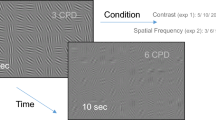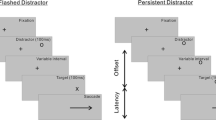Summary
The effects of visual attention and fixation upon the distribution of saccadic latencies: express (E-), fast regular (FR-), and slow regular (SR-) saccades were investigated. Extinguishing a fixation or an attention point 200–300 ms before target onset increases the incidence of E-saccades while concurrently decreasing the proportion of SR-saccades. Since this extinction forces a disengaging of attention, these changes in relative proportions of saccades reflect the elimination of one of the steps involved in programming saccades. It is shown that a previously attended stimulus has a favored status relative to other stimuli in the visual field. If, after being turned off, the previously attended fixation point or a peripheral attention stimulus is turned on near the time of the target's appearance, the occurrence of the E-saccades is greatly reduced. However, the appearance of any other stimulus in the visual field at or near the time of the target onset does not inhibit E-saccades. Contrary to the conclusions reached by Posner and Cohen (1984), a stimulus presented at the formerly attended location can attract attention more efficiently than a stimulus presented at another, new location.
Similar content being viewed by others
References
Andersen RA, Essick GK, Siegel RM (1985) Encoding of spatial location by posterior parietal neurons. Science 230: 456–458
Braun D, Breitmeyer BG (1988) Relationship between directed visual attention and saccadic reaction time. Exp Brain Res 73: 536–552
Bushnell MC, Goldberg ME, Robinson DL (1981) Behavioral enhancement of visual responses in monkey cerebral cortex. I. Modulation in posterior parietal cortex related to selective visual attention. J. Neurophysiol 46: 755–772
Fischer B (1987) The preparation of visually guided saccades. Rev Physiol Biochem Pharmacol 106: 1–35
Fischer B, Breitmeyer B (1987) Mechanisms of visual attention revealed by saccadic eye movements. Neuropsychology 25: 73–83
Fischer B, Ramsperger E (1984) Human express-saccades: extremely short reaction times of goal directed eye movements. Exp Brain Res 57: 191–195
Fischer B, Ramsperger E (1986) Human express saccades: effects of randomization and daily practice. Exp Brain Res 64: 569–578
Gauthier GM, Volle M (1975) Two dimensional eye movement monitor for clinical laboratory recordings. Electroencephalogr Clin Neurophysiol 39: 285–291
Gnadt JW, Andersen RA (1988) Memory related motor planning activity in the posterior parietal cortex of macaque. Exp Brain Res 70: 216–220
Goldberg ME, Brace CJ (1985) Cerebral cortical activity associated with the orientation of visual attention in the rhesus monkey. Vision Res 25: 471–481
Kalesnykas RP, Hallett PE (1987) The differentiation of visually guided and anticipatory saccades in gap and overlap paradigms. Exp Brain Res 68: 115–121
Keating EG, Gooley SG, Pratt SE, Kelsey JE (1983) Removing the superior colliculus silences eye movements normally evoked from stimulation of the parietal and occipital eye fields. Brain Res 269: 145–148
Lynch JC, Mountcastle VB, Talbot WH, Yin TCT (1977) Parietal lobe mechanisms for directed visual attention. J Neurophysiol 40: 362–389
Mayfrank L, Mobashery M, Kimmig H, Fischer B (1986) The role of fixation and visual attention on the occurrence of express saccades in man. Eur J Psychiatr Neurol Sci 235: 269–275
Mountcastle VB, Lynch JC, Georgopoulos A, Sakata H, Acuna C (1975) Posterior parietal association cortex of the monkey: command functions for operations within the extrapersonal space. J Neurophysiol 38: 871–908
Potter MC (1976) Short-term conceptual memory for pictures. J Exp Psychol General 109: 160–174
Posner MI, Cohen Y (1984) Components of visual orienting. In: Bouma H, Bowhuis D (eds) Attention and performance, Vol X. Erlbaum L, Hillsdale NJ, pp 531–556
Robinson DL, Goldberg ME, Stanton GB (1978) Parietal association cortex in the primate: sensory mechanisms and behavioral modulations. J Neurophysiol 41: 910–932
Ross LE, Ross SM (1980) Saccade latency and warning signals: stimulus onset, offset and changes as warning events. Percept Psychophys 27: 251–257
Ross LE, Ross SM (1985) Target information and eye movement latency. In: Groner R, McConkie GW, Menz C (eds) Eye movements and human information processing. Elsevier North-Holland, Amsterdam
Saslow MG (1967) Effects of components of displacement-step stimuli upon latency of saccadic eye movements. J Opt Soc Am 57: 1024–1029
Schiller PH, Sandell JH (1983) Interaction between visually and electrically elicited saccades before and after superior colliculus and frontal eye field ablations in the rhesus monkey. Exp Brain Res 49: 381–392
Schiller PH, Sandell JH, Maunsell JHR (1987) The effect of frontal eye field and superior colliculus lesions on saccadic latencies in the rhesus monkey. J Neurophysiol 57: 1033–1049
Shibutani H, Sakata H, Hyvärinen J (1984) Saccade and blinking evoked by microstimulation of the posterior parietal association cortex of the monkey. Exp Brain Res 55: 1–8
Sparks DL, Mays LE (1983) Spatial localization of saccade targets. I. Compensation for stimulation-induced perturbations in eye position. J Neurophysiol 49: 45–63
Author information
Authors and Affiliations
Rights and permissions
About this article
Cite this article
Braun, D., Breitmeyer, B.G. Effects of reappearance of fixated and attended stimuli upon saccadic reaction time. Exp Brain Res 81, 318–324 (1990). https://doi.org/10.1007/BF00228122
Received:
Accepted:
Issue Date:
DOI: https://doi.org/10.1007/BF00228122




